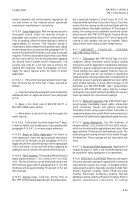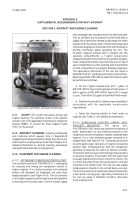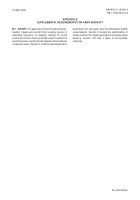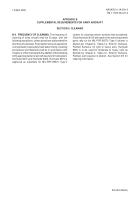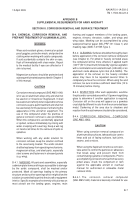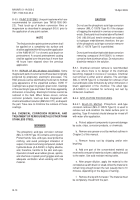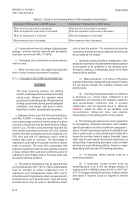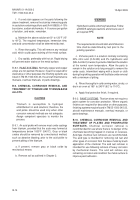TM-1-1500-344-23-2 - Page 209 of 240
B-7
NAVAIR 01-1A-509-2
TM 1-1500-344-23-2
15 April 2009
B-4. CHEMICAL CORROSION REMOVAL AND
PREPAINT TREATMENT OF ALUMINUM ALLOYS.
WARNING
Wear acid-resistant gloves, chemical or splash
proof goggles, protective mask, and protective
clothing when working with acidic compounds.
If acid accidentally contacts the skin or eyes,
flush off immediately with clean water. Report
to the medical facility if eyes are affected or if
skin is burned.
Magnesium surfaces should be protected and
subsequently treated as prescribed in Chapter 5
of this manual.
CAUTION
Corrosion removal compound (SAE AMS 1640)
is for use on aluminum alloys only and shall not
be used on or rinsed over magnesium. It shall
be used on aircraft only when required to remove
corrosion as a pre-paint treatment and shall not
be used solely for the purpose of enhancing the
appearance of the aircraft or equipment. The
use of this compound under the premise of
general corrosion removal is also prohibited.
When this compound is accidentally splashed
or spilled, remove immediately by rinsing with
water or wiping with a wet rag. Keep a wet rag
on hand at all times for the removal of spills or
splashes.
When working with any acidic solution for
corrosion removal, keep the solution confined
to the area being treated. The acidic solution
shall be kept away from operating mechanisms,
magnesium alloys, and steel parts, especially
steel screws and fasteners in stressed panels
(e.g. wing).
B-4.1. MASKING. All parts and assemblies, especially
cadmium plate items and hinges susceptible to damage
by the acidic compound, shall be masked and/or
protected. Mask all openings leading to the primary
structure and any other openings which might allow the
solution (uncontrolled) to get into the aircraft or equipment
interior. Specific examples of extremely critical areas on
most aircraft are the landing gears, engines, main
framing and support members of the landing gears,
engines, elevons, elevators, rudder, and wings and
wing stubs. Masking can be accomplished by using
waterproof barrier paper (MIL-PRF-131 Class 1) and
masking tape (AMS-T-21595 Type I).
B-4.2. CLEANING. Surfaces should be thoroughly clean
before application of the corrosion removal compound
(see Chapter 2). For pitted or heavily corroded areas
the compound will be more effective if applied warm
(140
°
F (60
°
C) maximum) followed by vigorous agitation
with a nonmetallic acid-resistant brush (H-B-643) or an
aluminum oxide abrasive nylon mat (A-A-58054). The
application of the remover on the heavily corroded
areas may have to be repeated several times to
completely remove the corrosion. When using the acid
remover, be sure to allow a sufficient dwell time (12 to
15 minutes) before rinsing.
B-4.3. INSPECTION. After each application, examine
the pits and/or corroded area with a 10 power magnifying
glass to determine if another application is required.
Corrosion still on the area will appear as a powdery
crust slightly different in color from the uncorroded base
metal. Darkening of the area due to shadows and
reaction from the acid remover should not be considered.
B-4.4. CORROSION REMOVAL COMPOUND
(SAE AMS 1640).
CAUTION
When using corrosion removal compound on
aluminum alloy surfaces, take particular care to
keep acid out of faying surfaces, butt joints,
seams, and crevices.
When using the flap brush to remove corrosion,
take action to control the particles or abrasives
that break away and prevent them from
contaminating systems or components. Prior to
accomplishing corrosion removal from severely
pitted areas, check the component or item
against the applicable aircraft or overhaul
manual for authorized or allowable metal
removal limits.
B-4.4.1. The corrosion removal compound
(SAE AMS 1640) material is basically intended for use
APPENDIX B
SUPPLEMENTAL REQUIREMENTS FOR ARMY AIRCRAFT
SECTION III. CORROSION REMOVAL AND SURFACE TREATMENT
Back to Top

